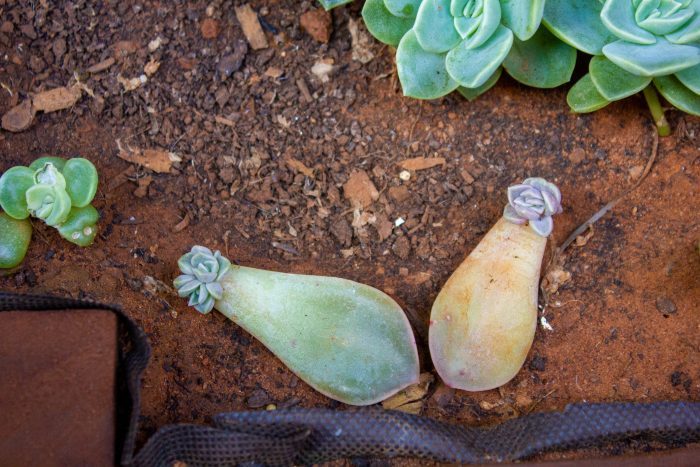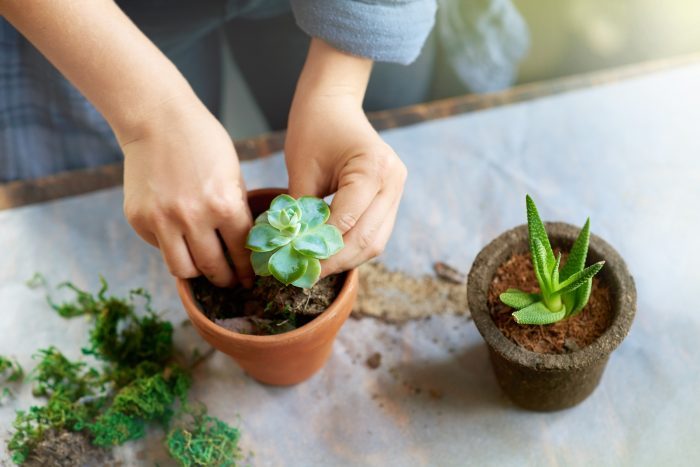Learning how to propagate succulents is easy, and it’s a great way to save money on new plants. Instead of buying more at the nursery, you can take cuttings, leaves or offsets from the succulents you already have.
Propagating succulents is also a fine way to enjoy a little gardening if you don’t have a green thumb. It requires a few simple steps, and succulents don’t need frequent care.
What Does It Mean to Propagate a Succulent?
To propagate means to reproduce. Some succulents can be propagated from leaves or stems, while other varieties can only be reproduced from one or the other. There are also varieties that grow offsets (baby succulents) you can propagate.
How to Take a Cutting
To create a new succulent from a stem, cut off a piece of stem from an existing plant. To take your cutting, it’s best to use a sharp, clean cutting tool like a pair of pruning shears to minimize damage to the plant.
Ideally, make your cut just above a leaf from a spot that keeps your parent plant looking nice or even improves its appearance. (Example: If the parent plant has grown tall and spindly, take your cutting from the overgrowth.) You may need to remove some lower leaves from the cutting so that you’re only planting the stem. Never plant leaves in the soil; the leaves will rot.
Once you have your cutting, there are two ways to proceed:
Option 1: Callous Method
Let the cut end callous over. When it’s dried out, tough and shriveled, the callous has formed. This process usually takes three to five days — less in a hot and dry climate, more in a cooler or wetter climate. Once calloused, your cutting is ready to plant.
This method is free, but it’s slower than the next method.
Option 2: Rooting Hormone Method
Dip the cut end in rooting hormone. Rooting hormone is a white powder with indole-3-butyric acid, a substance that mimics plants’ natural rooting hormone. Synthetic rooting hormone can help cuttings grow roots faster. A bottle that last ages costs less than $10.
Use a small spoon to remove a pinch of rooting hormone from the container it came in. (Be careful; don’t get this product on your skin.) Dip the cut end of your stem in the powder, tap the stem to remove the excess and toss the powder you don’t use. This way, you will avoid contaminating your entire container of rooting hormone if you’ve unwittingly taken a diseased cutting.
How to Plant Your Cutting
Whichever option you’ve chosen, plant your cutting in a pre-moistened, well-draining soil mix designed for succulents. You can buy a mix off the shelf like Miracle-Gro Cactus, Palm & Citrus Potting Mix that contains processed forest products, sphagnum peat moss, sand, perlite, a wetting agent and fertilizer.
Some succulent lovers prefer to make a custom soil mix. They might use coco peat (also called coconut coir) or horticultural pumice, and fertilize with a separate product like manure tea or Miracle-Gro Quick Start Planting & Transplanting Solution.
Don’t use garden soil, potting soil or sand to plant cuttings or mature succulents. These materials are dense and do not drain well, so your succulents will get waterlogged and rot. Use a growing medium with excellent drainage that isn’t hospitable to fungus or bacteria.
Do not water the soil immediately after planting your cutting. Instead, let the soil dry out. Then give it a good drenching, and don’t water again until the soil feels bone dry when you stick your finger two inches deep.
Initially, your cutting will be loose in its new home. After a few weeks, your succulent will start growing its root system. When you give it a gentle tug, you’ll notice it’s anchored in the soil. If you accidentally pull it out, just carefully replant it. After about a month you may want to feed your succulent with some plant food.
Propagating Succulents from Leaves

First, water your parent plant a few days before taking a leaf for a cutting to give the leaves the moisture they need to propagate.
To create a new succulent from a leaf, just twist and pull the leaf off the stem of the plant you want to propagate. It’s OK if a little bit of stem comes with your leaf. What you don’t want is a leaf that’s broken off before the stem, because a broken leaf won’t give you new plants.
Remove a juicy, healthy, mature leaf, not one that’s young, shriveled or overwatered. A yellow, translucent or black leaf is overwatered and unlikely to give you a new plant.
Once you have a good leaf, let the wet part where you removed it from the parent callous over. Keep your leaves in shade atop slightly moist succulent soil, coco peat or horticultural pumice.
Opinions differ on how, when and whether to water propagating leaves. Some houseplant gardeners say the leaves don’t need water. Others recommend dampening the leaves and soil with a spray bottle or plant mister every one to three days.
Still others say avoid watering the leaves because they could rot. They recommend using a succulent watering bottle with a long, thin, angled spout, to moisten only the part of the soil near the callous.
Certainly, there’s more than one way to succeed. If you live in a drier climate, you may need to mist or water your leaves. If you live in a humid climate, you might want to leave them alone.
When you start seeing baby succulents and/or roots growing out of the calloused end your leaf, which may take three weeks or more, move it to indirect bright or filtered sunlight. Keep your leaves in partial sun so your new plants and roots don’t dry out or get sunburned. In a few more weeks, your baby “pup” plants will be large enough to separate from the leaf and plant.
Pro tip: If you have pets, be aware that some succulents are poisonous to cats and dogs. Be careful about what you plant in your yard or bring into your home.
Propagating Succulents from Pups, Offsets, Chicks or Offshoots
Some succulents grow smaller versions of themselves, similar to what you’ll see if you propagate a leaf. You’ll usually see these at the succulent’s base or along the stem. These smaller versions have roots, and by gently removing them with the roots you can replant them right away. Some succulents even grow roots into the air! These babies are begging to be propagated.
This propagation method isn’t just a good way to get more plants. If the parent plant is in a pot, you’ll also avoid that pot becoming overcrowded with new growth.
What Are the Easiest Succulents to Propagate?

If you’re new to propagating succulents, help yourself out by choosing plants that are easy to grow. Keep an eye out for these types of succulents when you shop for plants online:
- Sedum morganianum (burro’s tail, donkey’s tail, burrito);
- Sedum rubrotinctum (jelly bean plant, pork and beans);
- Graptosedum “California Sunset;”
- Graptosedum “Alpenglow.”
You can use cuttings or leaves to propagate any of these.
By the way: The best time of year to propagate succulents is when they’re actively growing. Depending on where you live, that might be year-round. Or not.
Ideally, learn about the succulent you want to propagate. When is its growing season? When does it go dormant? When in doubt, propagate in the spring when the weather is warm.
Common Mistakes When Propagating Succulents
- Overwatering. The succulent will rot.
- Placing leaf cuttings in bright, direct sunlight. The cutting will be under too much stress. Tender new growth can dry out or get sunburned.
- Not using a plump, healthy leaf or stem. You’re far less likely to succeed if you start with a thirsty or sick plant.
- Using the wrong kind of soil. The wrong soil will hold too much moisture. That can invite fungal and bacterial growth or rot your cutting.
- Not being patient. It takes several weeks for cuttings to grow roots.
- Expecting every attempt to succeed. Some won’t, so take multiple cuttings or leaves from the plant you want to propagate. If 50 percent to 70 percent of them thrive, you’re doing a good job.
Can I Propagate Succulents in Water?

Yes, you can start growing the root system of your succulent leaf or stem by suspending it above the surface of a clear jar of water, or letting the calloused end dip into the water slightly. You might enjoy this method if you like watching the roots develop in full view, or if you prefer propagating succulents indoors during unfavorable growing conditions.
However, some people will find this method tedious. It requires changing the water to keep it clean and at the right level. When the cutting is smaller than the mouth of the jar, you might need to cover the jar with plastic wrap and poke a small hole in it. It works, but takes more effort.
Article source here: How to Propagate Succulents from a Cutting, Leaf or Pup


No comments:
Post a Comment